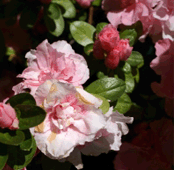Content
 Care
Care
Indoor flowers fill any room with the energy of life, create a mood and have a beneficial effect on health. In addition, we all know that only next to good people does greenery grow abundantly. It is also known that flowers react to a kind attitude towards them and from this bloom lush foliage. However, you won’t be fed up with warm care alone, so proper care of indoor plants is also a very important point.
What do indoor plants love?
Most of them still need light and warm air. These include, for example, oleander and hibiscus. They should be placed on the sunny side. But there are other flowers, such as chlorophytum, hydrangeas, begonias, tradescantia, aspidistra - they have the right place on the dimly lit windows of the north side.
In summer, it is recommended to take the plants to fresh air so that they breathe, you can shower with broad-leaved trees, washing off dust and refreshing from stuffiness. But do not forget to ensure that external stimuli do not harm your pets.
Indoor plants must be protected from harsh exposure: drafts, direct sunlight (curtain or newspaper), heaters and batteries. Aloe, tradescantia, dracaena, ficus, aspidistra are more or less patient with temperature fluctuations. There are, however, among indoor plants and "hardened", for example, primrose, geranium, hydrangea.
What soils are suitable for indoor flowers
Since the soil for plants is a vital element, you need to make sure that it is saturated with useful substances.
If you plan to plant shoots, then make the following composition: take one part of soddy soil and sand for two parts of leafy and humus soil. For large plants, such as ficus, make all the named soils in one part, and sod - three.
Watering indoor plants
Most flowers still do not like abundant moisture, especially cacti differ in this regard, aloe and agave are also not very moisture-loving. But large-leaved (say, ficus) love moisture. Before the next watering, pay attention to the topsoil: it must be dry. Prepare cool, but not cold water (not lower than 23 degrees), water not under the very root. Drain excess moisture from the pan so that the roots do not rot. For the same purpose, do not water too often. In winter, of course, less often.
Between March and September, remember to feed your plants about once a month. The lack of nutrients very quickly affects the appearance of flowers. If there is not enough nitrogen in the soil, the leaves of the plant become small and pale. Phosphorus deficiency will lead to the fact that the flower will less and less delight you with its flowering. Fertilizers will help correct the situation.
Keep an eye on the appearance of your plants: remove dry leaves in time, because, according to feng shui , dry foliage carries negative energy.
![]() At the same time, do not forget to wipe the flower leaves on both sides with damp cotton wool (or gauze) at least once a week. So they will breathe easier and they will look much nicer. Houseplant Care
At the same time, do not forget to wipe the flower leaves on both sides with damp cotton wool (or gauze) at least once a week. So they will breathe easier and they will look much nicer. Houseplant Care
![]() Transplanting Houseplants
Transplanting Houseplants
![]() Flower Pots: How to Choose
Flower Pots: How to Choose
![]() Houseplant Pests
Houseplant Pests
![]()
![]()
Houseplant Propagation Houseplant
![]() Fertilizers Hydroponics
Fertilizers Hydroponics
![]() Alocasia
Alocasia
![]() Aloe
Aloe
![]() Pineapple
Pineapple
![]() Araucaria
Araucaria
![]() Asparagus
Asparagus
![]() Aphelandra
Aphelandra
![]() Begonia
Begonia
![]() Geranium
Geranium
![]() Dieffenbachia
Dieffenbachia
![]()
![]()
Dracaena
![]() Cacti
Cacti
![]() Kalanchoe
Kalanchoe ![]()
Euphorbia
![]() Monstera
Monstera
![]() Tradescantia Ficus
Tradescantia Ficus
![]() Cyclamens
Cyclamens
PS If you liked the article, please press the buttons of social networks.

Leave a comment